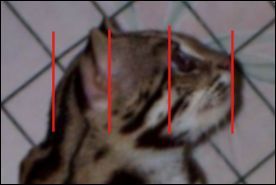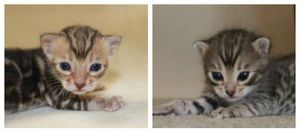 The first third of on the head of a small forest dwelling wildcat is the most important third of all. The front third of the head distinguishes this group of cats from all other wildcats on the planet.
The first third of on the head of a small forest dwelling wildcat is the most important third of all. The front third of the head distinguishes this group of cats from all other wildcats on the planet. On the left side of the collage above, there are three different species of small wildcats and on the right, the are three different species of larger cats. The cats on the left all hunt small prey: mice, birds, lizards. The cats on the right all hunt larger prey. The lion on top loves zebra and buffalo. The leopard in the middle feasts on gazelle and wildebeast, and the clouded leopard on the bottom enjoys deer, monkey, and pigs. Mother Nature is a beautiful creator, and she has designed the jaw of each cat to be the perfect size for a kill bite on the neck of that cat's favorite prey. Look at the cat's on the right side of the collage - the larger their prey is, the longer their muzzle is to accommodate a wider bite on a larger neck.
 The small cats of the jungles don't need muzzle length. If they had a longer muzzle, they would be less efficient killers of their prey species; thus, they would eventually die out. In addition, they are hunting in trees and brush and need to spot their prey beneath the tangled mess of branches and bushes, so their eyes must be low to see beneath everything. In contrast, a lion, for example, hunts on the grasslands and needs to hide beneath the tall grasses yet be able to look over those grasses without being seen. The lion needs its eyes up high. This low placement of the eyes on the small forest-dwelling wildcats gives their faces a unique, wild look as it is different from all other wildcats.
The small cats of the jungles don't need muzzle length. If they had a longer muzzle, they would be less efficient killers of their prey species; thus, they would eventually die out. In addition, they are hunting in trees and brush and need to spot their prey beneath the tangled mess of branches and bushes, so their eyes must be low to see beneath everything. In contrast, a lion, for example, hunts on the grasslands and needs to hide beneath the tall grasses yet be able to look over those grasses without being seen. The lion needs its eyes up high. This low placement of the eyes on the small forest-dwelling wildcats gives their faces a unique, wild look as it is different from all other wildcats. All of this background on prey size and muzzle length leads us to the front third of the Asian Leopard cat's head. In profile view, notice the eyes are on the front third of the skull. If breeders want to emulate the look of the small wildcats, they must select for Bengals who have their eyes on the front third of the skull as well.
All of this background on prey size and muzzle length leads us to the front third of the Asian Leopard cat's head. In profile view, notice the eyes are on the front third of the skull. If breeders want to emulate the look of the small wildcats, they must select for Bengals who have their eyes on the front third of the skull as well.Kitten skulls, however, are hard to evaluate. They change a lot as they grow. Determining if the eyes are appropriately set can sometimes be more easily done from the front view.
On the left side of the collage of kittens, there are small wildcat kittens - two Asian leopard cats and one margay. On the right side of the collage is a lion, leopard, and clouded leopard. Notice how low the eyes are on the faces of all the small wildcat kittens. From the front view, more than half the skull is above the eyes. In the larger cats with longer muzzles, the eyes are much higher on the face.
To select for Bengal kittens who will end up having their eyes on the front third of the skull, you need to look for eyes that are very low on the face. Often, the muzzle of a Bengal kitten will elongate down as the kitten grows. This means they eyes will end up higher on an adult Bengal than they appear on small kittens.
 In the collage of two infant Bengal kittens, you can see that the kitten on the left has higher set eyes than the kitten on the right. While it isn't as exaggerated as the small wildcat kittens, you can still see that over half the skull is above the eyes on the kitten on the left. When selecting kittens, make sure their eyes are on the lower half of the face when looking at it from the front view.
In the collage of two infant Bengal kittens, you can see that the kitten on the left has higher set eyes than the kitten on the right. While it isn't as exaggerated as the small wildcat kittens, you can still see that over half the skull is above the eyes on the kitten on the left. When selecting kittens, make sure their eyes are on the lower half of the face when looking at it from the front view.
Bengal breeders have all sorts of different wild looks that they are personally trying to achieve, and there are individual breeders who prefer the look of the large wildcats over the small wildcats. The TICA Bengal Standard says the overall goal of the breed is to "create a domestic cat which has physical features distinctive to the small forest-dwelling wildcats." The placement of the eyes is one of the most under utilized distinctive physical features of the small forest-dwelling wildcats within the Bengal breed. The Bengal head is suppose to be longer than it is wide, but if one is breeding for the look of the small forest-dwelling wildcats that length does not belong in the muzzle. It belongs behind the eyes.
These Blogs are written by Robyn Paterson with much of the content coming from the mind of Jon Paterson. Our intention is to help other Bengal breeders notice and select for features that are distinct to small forest dwelling wildcats, so we can better the breed together.
Read More. . .
Rule of Thirds - The Front Third
Rule of Thirds - The Middle Third
Rules of Thirds - The Back Third
Bengal Nose Set
Bengal Nose Size
Bengal Nose Shape




